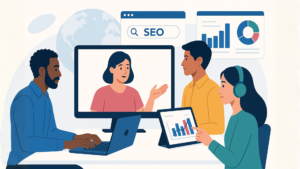Google Shopping Ads cost depends on the industry, competition, and platform. On average, you’ll spend $0.66 per click. Learn the typical costs and how to create cost-efficient campaigns for the highest ROI possible.
For ecommerce businesses, Google Shopping Ads are one of the fastest ways to get your products in front of high-intent buyers by appearing at the very top of the search engine results page (SERPs).
But before setting up your campaign, it’s important to understand what it will cost — and what kind of return to expect.
In this article, we’ll discuss Google Shopping Ads benchmarks and costs, as well as our top tips to maximize your ads budget.
How much do Google Shopping Ads cost?
From our ecommerce client data, the average cost per click (CPC) for Google Shopping Ads can range between $0.46 and $1.20. That number can vary depending on the competitiveness of your industry.
For example, the average CPC can be as low as $0.34 in the arts and music category and as high as $1.39 in the office and business supplies.
Why such a big difference?
- Competition: More advertisers bid in categories like office and business supplies, which drives up CPC.
- Bids: These products often carry higher profit margins, so companies can afford to bid more aggressively.
- Search intent: Arts and music searches tend to be more informational. For example, someone might research guitars for weeks before buying. But someone searching for a laptop stand is likely to buy right away. Higher buying intent makes advertisers more willing to pay a premium per click.
“While the CPCs may be high for a specific category, this may indicate that you can make significant revenue,” says Sam Yadegar, co-founder and CEO of HawkSEM.
Google Shopping Campaign costs breakdown
While CPC determines the bulk of campaign costs, it’s important to consider other costs.
Additional costs include:
- Agency fees: The average pay-per-click (PPC) management price is between $1,500 and $10,000 per month as a flat-fee model, or 10%-20% of your budget as a percentage of ad spend model.
- Third-party tools: You may use tools and platforms to manage your product listings on your behalf. For example, if you use Shopify, the Clever Ads app will automate your Performance Max (formerly Smart Shopping) ads using artificial intelligence (AI).
- Your time: If you manage your campaigns in-house, you’ll spend time updating your product data feed, optimizing your listings, and monitoring results.
“In our experience, each industry has its own cost metrics — not just CPC, but click-through rate (CTR), cost per acquisition (CPA), and average conversion rate,” says Yadegar.
“My advice would be to not only understand these metrics along with the competitive landscape, but to take a return on ad spend (ROAS) approach when using Google Shopping Ads.”
Google Shopping Ads costs compared to other campaigns
Do Google Shopping Ads cost more than other campaign types and PPC platforms? Let’s compare the costs.
- Google Search Ads vs. Google Shopping Ads
- Bing Shopping Ads vs.Google Shopping Ads
- Paid social vs. Google Shopping Ads
- Google Display Ads vs. Google Shopping Ads
Google Search Ads vs. Google Shopping Ads
Google Search Ads, also known as text ads or search campaigns, can be used by a wider range of businesses than Google Shopping Ads. As a result, there’s a lot more competition, which can drive up the cost.
The average CPC for Google Search Ads is $5.26, exponentially higher than Shopping Ads.
Alex Adekola, CEO and Founder at 808Beats, prefers the benefits of Google Shopping Ads over Search Ads.
“Not only do they appear at the top of the search results, they enable detailed product data like images, price, and additional information like whether free shipping is available,” shares Adekola.
“We’ve found Shopping Ads drive a 23% lower cost-per-conversion compared to Search Ads as a result.”
However, you can even use both ad types simultaneously, like Pottery Barn has done here:
Bing Shopping Ads vs. Google Shopping Ads
Bing Shopping Ads, also known as Microsoft Advertising shopping campaigns, are similar to Google Shopping but with a smaller audience and, in many cases, a lower CPC.
The average CPC across all Bing Ads (including search and display) is about $1.54.
Why are Bing Shopping Ads cheaper on average? Less competition — fewer advertisers bid on Bing, which means lower costs.
That said, the lowest-cost industries on Google Shopping Ads aren’t always the cheapest on Bing. For instance, the arts and music category averages just $0.34 per click on Google, but a staggering $3.39 on Bing.
This discrepancy comes down to user demographics. Bing’s audience skews typically older and more affluent than Google’s, which can influence both demand and advertiser bidding behavior.
So, while Bing Shopping Ads is cheaper, this doesn’t automatically make it the better option. The best platform for your business depends on what you sell and who your buyers are.
Let’s Crush Your Marketing Goals
Get a tailor-made plan that helps our clients see an average 4.5X ROI.
Free Marketing Plan
Paid social vs. Google Shopping Ads
The cost of ads on social media varies widely depending on the platform and ad formats. For example, the average CPC on TikTok is around $1, while Instagram averages $1.24.
Why the variation? Several factors play a role.
- Platform popularity: Larger platforms (like Facebook) attract more advertisers, which can increase costs compared to smaller platforms (like Pinterest)
- Target demographics: When more brands compete to reach the same audience, ad prices go up
- Specific products being sold: Higher-ticket items tend to drive higher CPCs since advertisers are willing to spend more to acquire a customer
- Ad format: Some ad formats are more popular than others, which changes the cost
- Ad objective: Campaigns optimized for conversions usually cost more than those focused on impressions or engagement
Google Shopping targets people who have a high purchase intent, which is why clicks tend to be more expensive — but also yield higher conversion rates.
Social ads usually have a lower CPC but reach people earlier in the buying journey.
They create demand rather than just capturing it, which can ultimately boost conversions — though it often takes more impressions and clicks to get there.
Google Display Ads vs. Google Shopping Ads
Google Shopping Ads and Google Display Ads have a lot in common. They both use visuals to encourage searchers to click and convert.
They’re also both more affordable than Google Search Ads, with Display Ads costing $0.63 per click on average.
However, Shopping and Display Ads serve different purposes. Google Shopping Ads target customers at the bottom of the sales funnel who are ready to buy.
Google Display Ads raise brand awareness for customers at the top of the sales funnel.
The exception to the rule? Remarketing display ads.
These ads appear to customers who have visited your online store before, encouraging them to come back and purchase the products they viewed.
Google Shopping Ads and Remarketing Display Ads complement each other to drive conversions
Use Shopping Ads to attract potential customers to your site, and if they don’t purchase right away, follow up with Remarketing Display Ads to re-engage them and keep your products top-of-mind.
How to optimize Google Shopping CPC
While the average cost per click on Google Shopping Ads largely depends on what you sell, there are steps you can take to lower costs and improve performance.
We asked our expert PPC team for their top tips:
- Structure campaigns correctly
- Use negative keywords to eliminate wasted clicks
- Target the right audience
- Optimize product pages for user experience
- Monitor performance and optimize accordingly
1. Structure campaigns correctly
Before launching a Google Shopping campaign, you must add your product data to your Google Merchant Center account.
You can do this manually or through your ecommerce platform (like Shopify or WooCommerce).
Organizing your product feed properly makes it easier to manage your listings and control bids, which can ultimately reduce CPC. Here’s how:
- Provide complete, accurate product data. The more detailed your product listings, the more likely they are to convert.Group products into categories. Group products (e.g., maxi, midi, and mini dresses) to set unique bids and create more targeted campaigns.
- Use custom labels. Segment products by attributes like clearance, seasonal, or best-sellers to adjust bids and highlight key items.
2. Use negative keywords to eliminate wasted clicks
Negative keywords ensure your Google Shopping Ads show to the right people by allowing you to exclude irrelevant search terms from triggering your ads.
For example, if you sell luxury items, excluding search queries like “sale” and “cheap” keeps your ad from showing to those less likely to convert.
Regularly adding new negative keywords can reduce wasted ad spend and keep your CPC low.
3. Target the right audience
Precise targeting helps your Shopping Ads reach the customers most likely to convert — and prevents wasted spend on irrelevant ad clicks.
“One of the most common mistakes is businesses casting their net too wide,” says Adam Palmer, a PPC executive at Imaginaire.
“We implemented a fixed schedule for one of our clients to counteract wasteful spending in the early morning hours. This, alongside other tweaks, led to a 28% reduction in ad spend whilst maintaining conversion value.”
Other targeting strategies include:
- Demographics: Narrow your audience by age, gender, location, income, or parental status.
- Affinity audiences: Reach users with specific hobbies and interests relevant to your products.
- Device targeting: Adjust bids by desktop or mobile — and on mobile, even by operating system or phone type.
4. Optimize product pages for user experience
Product pages should be easy to use, mobile-friendly, and provide potential customers with all the necessary product information.
This leads to increased conversions and a higher ROAS.
According to Baymard, only half of the top-grossing US and European ecommerce sites have a “decent” or “good” performance.
A strong product landing page increases your Quality Score, which reduces your average CPC.
Increasing your Quality Score from 5 to 10 means you save money by paying 50% less per click.
5. Monitor performance and optimize accordingly
Consistent monitoring is key to lowering costs and improving results. For smaller campaigns, check performance once or twice a week; for larger or more complex campaigns, review them daily.
Optimization tips for Shopping Ads campaigns include:
- Track performance trends: Watch impressions, clicks, and conversions for sudden spikes or drops.
- Shift budget strategically: Allocate more spend to high-performing products and reduce or exclude low performers.
- Refine product data: Update weak titles or images, fix feed errors, and ensure details match your website.
- Use smart bidding: Adjust bids per product, bid higher on best sellers, and lower bids on underperformers.
- Expand and refine targeting: Add relevant keywords, refresh negative keywords, and use remarketing to re-engage past visitors.
- Test and iterate: Run A/B tests on creative, product images, or feed attributes to see what drives better engagement.
Optimization tools simplify management and optimization to improve ad performance, especially for large product catalogs.
“We use ConversionIQ (CIQ) to granularly track every single step of the buyer journey, from first click to conversion,” says Yadegar.
“This lets us see what aspects of a Google Shopping Ad are working, and where we can make changes to improve cost-effectiveness, meaning we can optimize towards a higher ROAS.”
Bonus: “CIQ provides more insight about the target audience — we can take that data and use it on another marketing channel (for example, SEO) to further scale while maintaining profitability.”
How recent trends will affect Google Shopping Ads costs
While it’s always tricky to predict the future, we’ve identified two key trends that may affect the cost of Google Shopping Ads in the upcoming years: AI and the uncertainty of third-party cookies.
AI and automation
Google Ads is increasingly using AI to automate the advertising process through features like Smart Bidding, which uses AI to adjust bids to maximize the number of clicks and conversions received.
- Potential benefit: AI can reduce costs by optimizing bids more efficiently than manual management
- Potential drawback: An automated bidding strategy may prioritize conversions over cost, which increases bids in competitive markets
Third-party cookies
While Google no longer has a timeline for eliminating third-party cookies entirely as originally planned, it is focusing on a more privacy-focused approach.
With initiatives like the Privacy Sandbox, Google is replacing cross-site tracking with tools that allow advertisers to target users while keeping more of their data on-device.
For Google Shopping Ads, this still means there will be less reliance on third-party data to retarget and build audiences, which may drive up costs in Google Ads accounts.
The shift may also create more competition for high-quality first-party audiences, potentially raising costs if advertisers bid more aggressively to reach these refined groups.
The takeaway
Google Shopping Ads is one of the more affordable ways to promote your business if you’re in the ecommerce industry.
However, to ensure a cost-effective campaign, put the work in and stay one step ahead of the competition.
If you want to make the most of your daily budget, our expert team can help. Reach out today.
This article has been updated and was originally published in April 2024.







